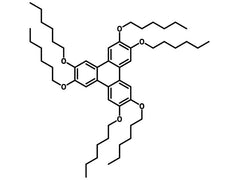2,3,6,7,10,11-Hexakis(hexyloxy)triphenylene - HAT6
CAS Number 70351-86-9
Charge Transport Layer Materials, Liquid Crystals, Materials, OLED Materials,Discotic Liquid Crystals (DLCs) with Triphenylenes
A model molecule for DLC studies and a hole transport layer for perovskite solar cells
Specifications | MSDS | Literature and Reviews
2,3,6,7,10,11-Hexakis(hexyloxy)triphenylene, also known as HAT6 (CAS number 70351-86-9), has a hexagonal fused triphenylene core structure. Six n-hexyloxy side chains are symmetrically distributed onto the triphenylene core at 2,3,6,7,10,11-positions. The six side chains are there to promote solubility in organic solvents and enhance electron density of the triphenylene core. Study showed that the dynamics of the cores and tails of discotic molecules are strongly correlated. HAT6 has been referred to as the model molecule for the study of the DLCs.
At room temperature, HAT6 is a plastic crystal where the cores are tilted with respect to the columnar axes. Two phase transition temperatures at about 65 °C and 100 °C are observed in the differential scanning calorimetry study of HAT6. This corresponds to the melting of the columnar hexagonal (ColH) and plastic crystalline phases into the isotropic and ColH phases, respectively.
HAT6 DLC has also been employed as a transparent hole transport material for perovskite solar cells to promote ambient and thermal stability. These perovskite solar cell devices retained 93% of the initial efficiency for 690 h and 92% after 1200 h under ambient conditions.
General Information
| CAS Number | 70351-86-9 |
|---|---|
| Chemical Formula | C54H84O6 |
| Molecular Weight | 829.24 g/mol |
| Absorption* | λmax 278 nm (in DCM) |
| Fluorescence | n.a. |
| HOMO/LUMO | HOMO = 5.23 eV, LUMO = 1.88 eV (Eg = 3.35) [1] |
| Synonyms | H6TP, HHOTP, HAT6 |
| Classification or Family | Triphenylene, Discotic liquid crystals, Hole transport layer materials. |
Product Details
| Purity | >98% (HPLC) |
|---|---|
| Melting Point | DSC: Tg = 65 °C, 100 °C |
| Appearance | Off-white to pale yellow powder/crystal |
* Sublimation is a technique used to obtain ultra pure-grade chemicals, see sublimed materials for OLED devices.
Chemical Structure

MSDS Documentation
HAT6 - 2,3,6,7,10,11-Hexakis(hexyloxy)triphenylene MSDS Sheet
Literature and Reviews
- Synthesis and investigation on liquid crystal and optical properties of dyads based on triphenylene and perylene, X. Kong et al., RSC Adv., 7, 17030 (2017); DOI: 10.1039/c7ra01320e.
-
Dynamics of a Triphenylene Discotic Molecule, HAT6, in the Columnar and Isotropic Liquid Phases, F. Mulder et al., J. Am. Chem. Soc., 125 (13), 3860–3866 (2003); DOI: 10.1021/ja029227f.
-
Molecular ordering of the discotic liquid crystal HAT6 confined in mesoporous solids, S. Całus et al., Microporous Mesoporous Mater., 197, 26-32 (2014); DOi: 10.1016/j.micromeso.2014.05.036.
